Saturday, September 21. 2013
fabric | ch new project: a geo-engineered troposphere in the form of open data feeds (@Close_Closer)
By fabric | ch
-----
Deterritorialized Living is a new project by fabric | ch that we've just published online last week, in relation with the Call and the Talks we are presenting during Close, Closer, the 3rd Lisbon Architecture Triennale curated by Beatrice Galilee (first talk is today, September, 21 at 5pm, LX Factory, Rua Rodrigues Faria, Lisbon, while the second one will be on December, 14).
This project is the result of a residency we did in Beijing last spring, at the Tsinghua University (TASML) and has certainly some unconscious relation with the experience of climate we had in the city!
http://www.deterritorialized.org, the server of Deterritorialized Living, the artificial and livable troposphere.
Deterritorialized Living is an artificial troposphere that reverses our causal relationship to the natural rhythms of day and night, air, seasons, time. It is a “man made” environment where the atmosphere is the effect, continuously shaped from the global activities on the networks produced by humans and robots. The aim of this artificial, almost fictional atmosphere is to give permanent presence (at this stage only in the form of data flows) to what has paradoxically become an ambient, "atmospheric" and contextual experience of deterritorialisation / detemporalisation induced by the massive use of networks, transportation devices, flows of data or communication technologies. Therefore, to literally become able to "breathe" the environment we are generating through our common actions. To some extent, Deterritorialized Living could then also be considered as an information design, delivered in the form of an atmosphere.
As the result of its initial and designed rules, this milieu develops strange behaviors: daylight is always “on” (as there are always activities on the networks) but at variable strengths, nighttime never occurs, air composition regularly reaches “physiological enhancement” levels of high altitude, it is composed of a unique single day that goes back and forth and that ideally last forever, continuous. There are no months, no years.
Deterritorialized Living is delivered in the form of open data feeds which define this “geo-engineered” yet livable environment, computed by the deterritorialized.org server. We expect to develop and use the troposphere in the future in the form of installations, responsive devices and architecture projects.
But the artificial troposphere is also freely available to architects, artists, designers, scientists and makers of all kinds in the form of different “services”: Deterritorialized Air (N2, O2, CO2, Ar), Deterritorialized Daylight (visible light Intensity, IR, UV) and Deterritorialized Time (HH:MM:SS). Additional feeds and refined rules will be added along the time to mature this generated atmosphere.
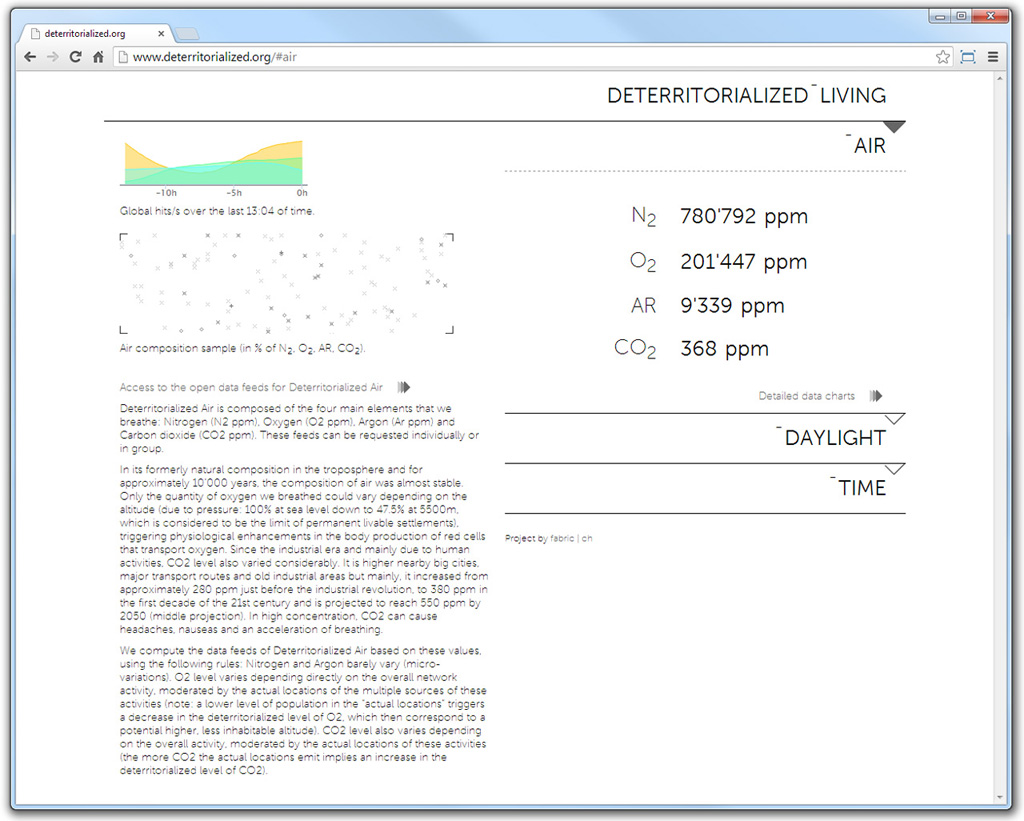

The live parameters, data and charts that show the evolution of values for Deterritorialized Air (N2, O2, AR, CO2).
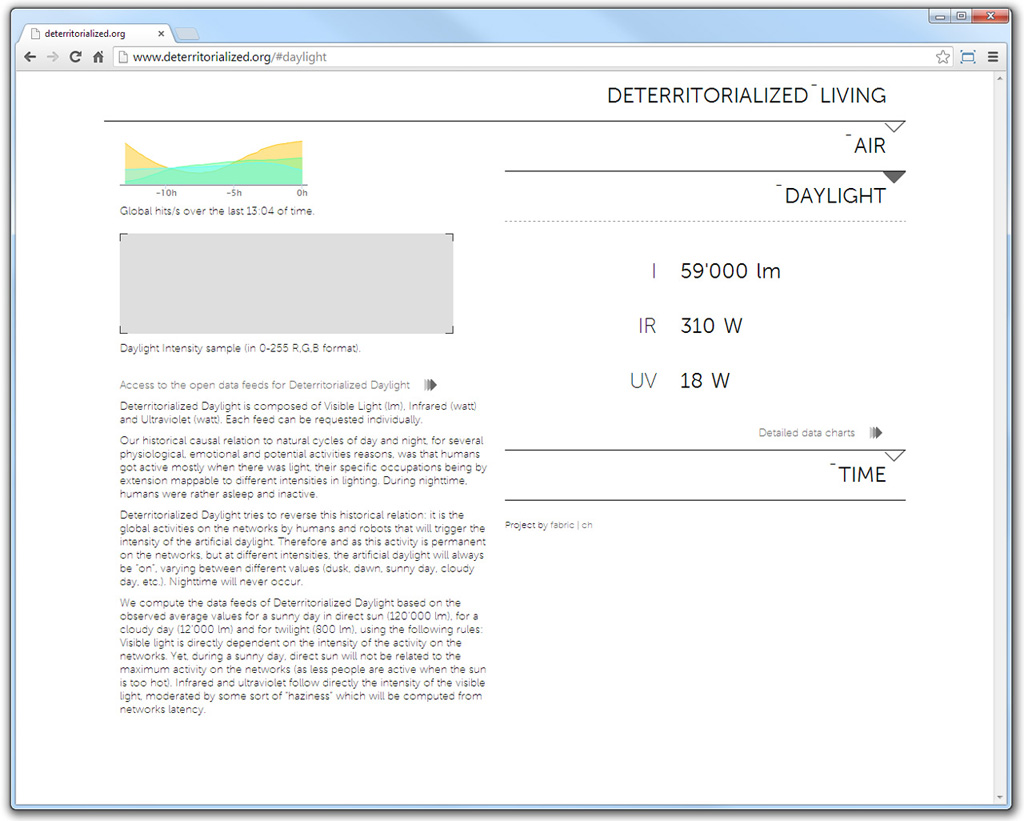
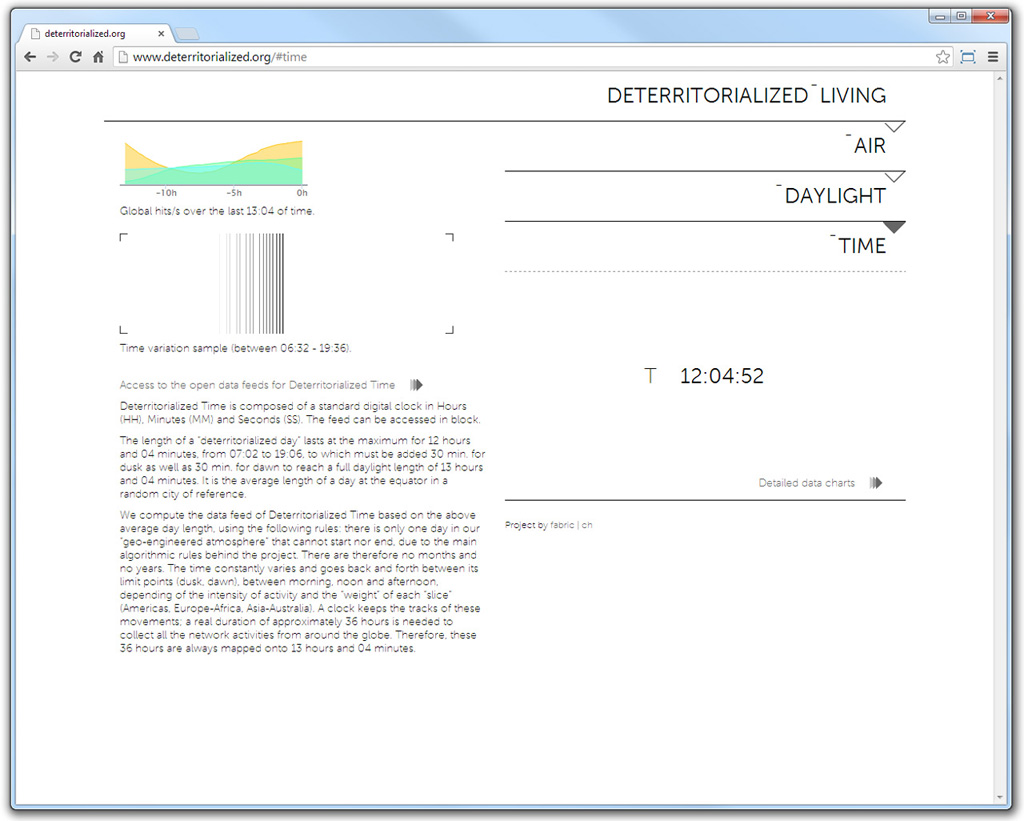

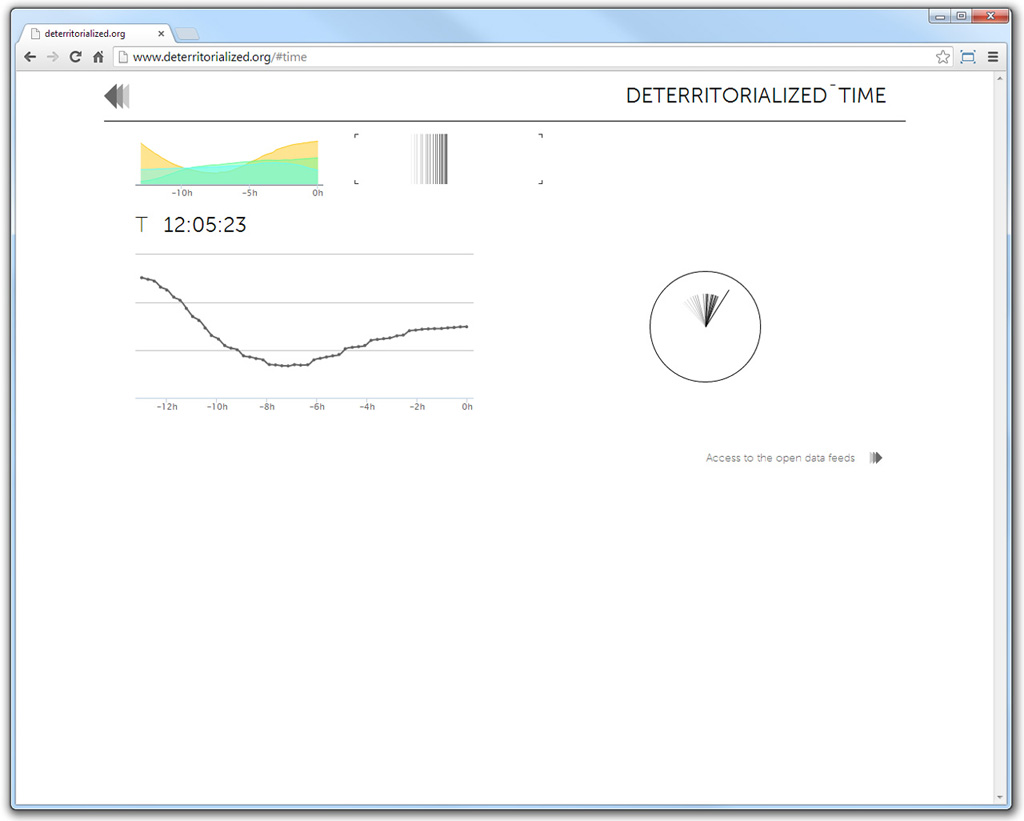
Values for Deterritorialized Daylight, including Intensity (lm, visible light), Infrared (w) and ultraviolet (w) as well as Deterritorialized Time (HH:MM:SS), with their related charts. It is interesting to note that the generated time changes along time... but not in a linear manner, it varies between 06:32 and 19:36.

Man page explaining how to access the different data feeds for the ones who would like to develop their own project out of Deterritorialized Living.
These algorithmically designed data feeds can therefore be used independently or combined to drive experimental devices, interfaces, software and speculative livable environments of all kinds (under the responsibility of their authors...).
Let us know if you'll be using it!
Related Links:
Friday, September 20. 2013
How to make players sick in your virtual reality game
Via Joystiq
-----
There is a great, undiscovered potential in virtual reality development. Sure, you can create lifelike virtual worlds, but you can also make players sick. Oculus VR founder Palmer Luckey and VP of product Nate Mitchell hosted a panel at GDC Europe last week, instructing developers on how to avoid the VR development pitfalls that make players uncomfortable. It was a lovely service for VR developers, but we saw a much greater opportunity. Inadvertently, the panel explained how to make players as queasy and uncomfortable as possible.
And so, we now present the VR developer's guide to manipulating your players right down to the vestibular level. Just follow these tips and your players will be tossing their cookies in minutes.
Note: If you'd rather not make your players horribly ill and angry, just do the opposite of everything below.
Include lots of small, tight spaces
In virtual reality, small and closed-off areas truly feel small, said Luckey. "Small corridors are really claustrophobic. It's actually one of the worst things you can do for most people in VR, is to put them in a really small corridor with the walls and the ceiling closing in on them, and then tell them to move rapidly through it."
Meanwhile, open spaces are a "relief," he said, so you'll want to avoid those.
Possible applications: Air duct exploration game.
Create a user interface that neglects depth and head-tracking
Virtual reality is all about depth and immersion, said Mitchell. So, if you want to break that immersion, your ideal user interface should be as traditional and flat as possible.
For example, put targeting reticles on a 2D plane in the center of a player's field of view. Maybe set it up so the reticle floats a couple of feet away from the player's face. "That is pretty uncomfortable for most players and they'll just try to grapple with what do they converge on: That near-field reticle or that distant mech that they're trying to shoot at?" To sample this effect yourself, said Mitchell, you can hold your thumb in front of your eyes. When you focus on a distant object, your thumb will appear to split in two. Now just imagine that happening to something as vital a targeting reticle!
You might think that setting the reticle closer to the player will make things even worse, and you're right. "The sense of personal space can make people actually feel uncomfortable, like there's this TV floating righting in front of their face that they try to bat out of the way." Mitchell said a dynamic reticle that paints itself onto in-game surfaces feels much more natural, so don't do that.
You can use similar techniques to create an intrusive, annoying heads-up display. Place a traditional HUD directly in front of the player's face. Again, they'll have to deal with double vision as their eyes struggle to focus on different elements of the game. Another option, since VR has a much wider field of view than monitors, is to put your HUD elements in the far corners of the display, effectively putting it into a player's peripheral vision. "Suddenly it's too far for the player to glance at, and they actually can't see pretty effectively." What's more, when players try to turn their head to look at it, the HUD will turn with them. Your players will spin around wildly as they desperately try to look at their ammo counter.
Possible applications: Any menu or user interface from Windows 3.1.
Disable head-tracking or take control away from the player
"Simulator sickness," when players become sick in a VR game, is actually the inverse of motion sickness, said Mitchell. Motion sickness is caused by feeling motion without being able to see it ? Mitchell cited riding on a boat rocking in the ocean as an example. "There's all this motion, but visually you don't perceive that the floor, ceiling and walls are moving. And that's what that sensory disconnect ? mainly in your vestibular senses ? is what creates that conflict that makes you dizzy." Simulator sickness he said, is the opposite. "You're in an environment where you perceive there to be motion, visually, but there is no motion. You're just sitting in a chair."
If you disable head-tracking in part of your game, it artificially creates just that sort of sensory disconnect. Furthermore, if you move the camera without player input, say to display a cut-scene, it can be very disorienting. When you turn your head in VR, you expect the world to turn with you. When it doesn't, you can have an uncomfortable reaction.
Possible applications: Frequent, Unskippable Cutscenes: The Game.
Feature plenty of backwards and lateral movement
Forward movement in a VR game tends not to cause problems, but many users have trouble dealing with backwards movement, said Mitchell. "You can imagine sometimes if you sit on a train and you perceive no motion, and the train starts moving backwards very quickly, or you see another car pulling off, all of those different sensations are very similar to that discomfort that comes from moving backwards in space." Lateral movement ? i.e. sideways movement ? has a similar effect, Mitchell said. "Being able to sort of strafe on a dime doesn't always cause the most comfortable experience."
Possible applications: Backwards roller coaster simulator.
Quick changes in altitude
"Quick changes in altitude do seem to cause disorientation," said Mitchell. Exactly why that happens isn't really understood, but it seems to hold true among VR developers. This means that implementing stairs or ramps into your games can throw players for a loop ? which, remember, is exactly what we're after. Don't use closed elevators, as these prevent users from perceiving the change in altitude, and is generally much more comfortable.
Possible applications: A VR version of the last level from Ghostbusters on NES. Also: Backwards roller coaster simulator.
Don't include visual points of reference
When players look down in VR, they expect to see their character's body. Likewise, in a space combat or mech game, they expect to see the insides of the cockpit when they look around. "Having a visual identity is really crucial to VR. People don't want to look down and be a disembodied head." For the purposes of this guide, that makes a disembodied head the ideal avatar for aggravating your players.
Possible applications: Disembodied Heads ... in ... Spaaaaaace. Also: Disembodied head in a backwards roller coaster.
Shift the horizon line
Okay, this is probably one of the most devious ways to manipulate your players. Mitchell imagines a simulation of sitting on a beach, watching the sunset. "If you subtly tilt the horizon line very, very minimally, a couple degrees, the player will start to become dizzy and disoriented and won't know why."
Possible applications: Drunk at the Beach.
Shoot for a low frame rate, disable V-sync
"With VR, having the world tear non-stop is miserable." Enough said. Furthermore, a low frame rate can be disorienting as well. When players move their heads and the world doesn't move at the same rate of speed, its jarring to their natural senses.
Possible applications: Limitless.
In Closing
Virtual reality is still a fledgling technology and, as Luckey and Mitchell explained, there's still a long way to go before both players and developers fully understand it. There are very few points of reference, and there is no widely established design language that developers can draw from.
What Luckey and Mitchell have detailed - and what we've decided to ignore - is a basic set of guidelines on maintaining player comfort in the VR space. Fair warning though, if you really want to design a game that makes players sick, the developers of AaaaaAAaaaAAAaaAAAAaAAAAA!!! already beat you to it.
How Mechanical Turkers Crowdsourced a Huge Lexicon of Links Between Words and Emotion
-----
Sentiment analysis on the social web depends on how a person’s state of mind is expressed in words. Now a new database of the links between words and emotions could provide a better foundation for this kind of analysis.
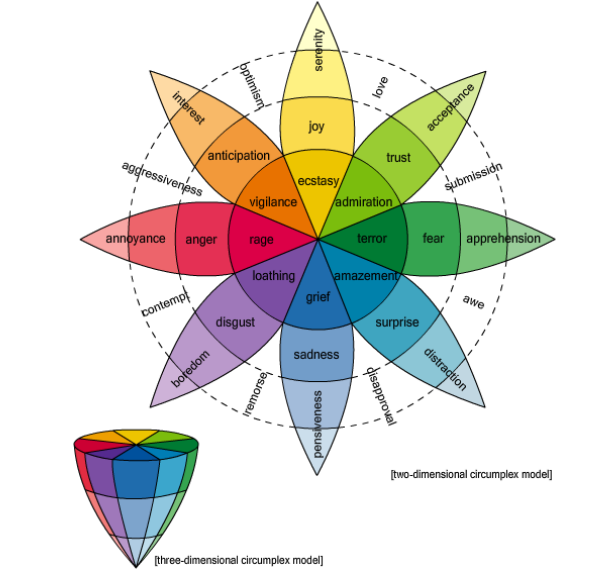
One of the buzzphrases associated with the social web is sentiment analysis. This is the ability to determine a person’s opinion or state of mind by analysing the words they post on Twitter, Facebook or some other medium. Much has been promised with this method—the ability to measure satisfaction with politicians, movies and products; the ability to better manage customer relations; the ability to create dialogue for emotion-aware games; the ability to measure the flow of emotion in novels; and so on. The idea is to entirely automate this process—to analyse the firehose of words produced by social websites using advanced data mining techniques to gauge sentiment on a vast scale. But all this depends on how well we understand the emotion and polarity (whether negative or positive) that people associate with each word or combinations of words. Today, Saif Mohammad and Peter Turney at the National Research Council Canada in Ottawa unveil a huge database of words and their associated emotions and polarity, which they have assembled quickly and inexpensively using Amazon’s crowdsourcing Mechanical Turk website. They say this crowdsourcing mechanism makes it possible to increase the size and quality of the database quickly and easily. Most psychologists believe that there are essentially six basic emotions– joy, sadness, anger, fear, disgust, and surprise– or at most eight if you include trust and anticipation. So the task of any word-emotion lexicon is to determine how strongly a word is associated with each of these emotions. One way to do this is to use a small group of experts to associate emotions with a set of words. One of the most famous databases, created in the 1960s and known as the General Inquirer database, has over 11,000 words labelled with 182 different tags, including some of the emotions that psychologist now think are the most basic. A more modern database is the WordNet Affect Lexicon, which has a few hundred words tagged in this way. This used a small group of experts to manually tag a set of seed words with the basic emotions. The size of this database was then dramatically increased by automatically associating the same emotions with all the synonyms of these words. One of the problems with these approaches is the sheer time it takes to compile a large database so Mohammad and Turney tried a different approach. These guys selected about 10,000 words from an existing thesaurus and the lexicons described above and then created a set of five questions to ask about each word that would reveal the emotions and polarity associated with it. That’s a total of over 50,000 questions. They then asked these questions to over 2000 people, or Turkers, on Amazon’s Mechanical Turk website, paying 4 cents for each set of properly answered questions. The result is a comprehensive word-emotion lexicon for over 10,000 words or two-word phrases which they call EmoLex. One important factor in this research is the quality of the answers that crowdsourcing gives. For example, some Turkers might answer at random or even deliberately enter wrong answers. Mohammad and Turney have tackled this by inserting test questions that they use to judge whether or not the Turker is answering well. If not, all the data from that person is ignored. They tested the quality of their database by comparing it to earlier ones created by experts and say it compares well. “We compared a subset of our lexicon with existing gold standard data to show that the annotations obtained are indeed of high quality,” they say. This approach has significant potential for the future. Mohammad and Turney say it should be straightforward to increase the size of the date database and at the same technique can be easily adapted to create similar lexicons in other languages. And all this can be done very cheaply—they spent $2100 on Mechanical Turk in this work. The bottom line is that sentiment analysis can only ever be as good as the database on which it relies. With EmoLex, analysts have a new tool for their box of tricks. Ref: arxiv.org/abs/1308.6297: Crowdsourcing a Word-Emotion Association Lexicon.
Tuesday, September 10. 2013
fabric | ch at Close, Closer - Lisbon Architecture Triennale
By fabric | ch
-----
We are glad to announce that we'll be taking part with an Associated Project to the next Lisbon Architecture Triennale (Close, Closer, cur. Beatrice Galilee) that will take place between September 12 and December 15, 2013.
.jpg)
Img: I-Weather as Deep Space Public Lighting, fabric | ch, 2010 01SJ, San Jose.
Project:
The work we'll present with fabric | ch, in collaboration with TASML, will be in fact a call for projects (!): Deterritorialized Living (the Beijing sessions) / Inhabiting the Computer Cabinet. It follows the residency and the work we produced in Beijing last Summer at the Tsinghua University. The call is open to the international community as well as specifically to the Tsinghua University (two different dedicated awards).
We will also present two talks. On the 21st of September, I'll present this call, some related projects by fabric | ch and the results of our residency in Beijing at the LX Factory (CoworkLisboa, 103 Rua Rodrigues Faria, PIso 4). On the 14th of December, we'll present along with TASML the results of the call, with a presentation by the winning entry from China.
Dates:
30.08. - Competition launch. Tsinghua University, Beijing
21.09. 5pm - Talk by fabric | ch: Deterritorialized Living. At the LX Factory, Lisbon
14.10. Competition submissions deadline, Beijing
01.11. Announcement of winning entries
14.12., 5pm - Talk by the winner of the competition, along with fabric | ch & TASML. At the LX Factory, Lisbon
Call: http://call.deterritorialized.org
Program in Lisbon: http://beijing.deterritorialized.org/
Close, Closer: http://www.close-closer.com/en/
Open call by fabric | ch & TASML: Deterritorialized Living / Inhabiting the Computer Cabinet
By fabric | ch
-----
Following our residency in Beijing at the Tsinghua University that ended last July, fabric | ch transformed itself into the organizers of a call (!) that will run between next september and october, in partneship with TASML (Beijing). The call is closely related to the work and workshop we've done in Beijing.
The results of this CALL (1st price) will be presented during the next Lisbon Architecture Triennale, CLOSE, CLOSER (curator Beatrice Galilee), so as another list of EVENTS, as an Associated Program and during a talk together with fabric | ch.
An Award of Distinction is open to international submissions.
You can find below a copy of this open call dedicated to individuals or interdisciplinary groups of students and faculty members of Tsinghua University in the fields of Architecture, Design, Art and Sciences (1st prize), so as to the international community (students and professionals, Award of Distinction).
Call: http://call.deterritorialized.org/
Download the call in pdf: http://bit.ly/18LozDr
Download the poster: http://bit.ly/1amu7Gk
Events during Close, Closer: http://beijing.deterritorialized.org/
Please spread the message!
-----
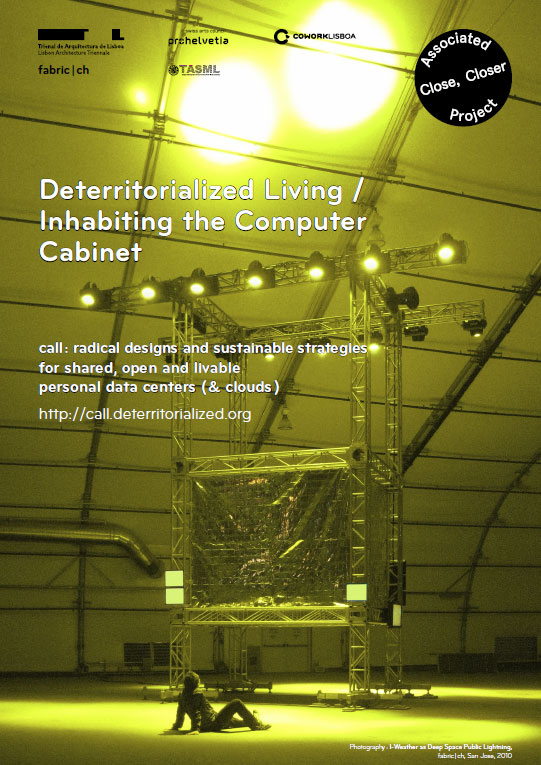
Download the call in English (PDF)
Download the call in Chinese (PDF)
Call : radical designs and sustainable strategies for shared, open and livable personal data centers (& clouds)
In collaboration with fabric | ch, Tsinghua Art & Sciences Research Center Media Laboratory (TASML) is pleased to announce an open call to the Tsinghua community for individuals or interdisciplinary groups of students and faculty in the fields of Architecture, Design, Art and Sciences. Conceived by fabric | ch, the competition is inspired by Deterritorialized Living, a workshop, a project and series of online “tools / atmospherics” developed on the Tsinghua campus during a recent residency.
The purpose of the competition is to explore a radicalized experience of deterritorialisation / detemporalization through intensive use of network, transportation and sometimes biochemical devices as well as to investigate alternative strategies in lieu of corporate approaches to data, data centers and cloud computing. The competition aims to develop speculative and innovative artifacts (code, interfaces, programs, objects, devices, spaces, etc.) for this contemporary situation.
Inhabiting the Computer Cabinet competition (Deterritorialized Living, the Beijing sessions) will be an Associated Project during Close, Closer, the much anticipated Lisbon Architecture Triennale that will take place in late summer and fall of 2013, curated by Beatrice Galilee, Liam Young, Mariana Pestana and Jose Esparza Chong Cuy.
Brief

One of the first general purpose computer, the Eniac I, back in 1946.
Context: Since the public emergence of the Internet and the web in the mid ’90s and the ubiquitous presence of wireless communication, peer to peer exchanges, and social networks of all kinds in recent years, we have witnessed a growing tendency towards horizontally mediated decentralization. These conditions have not only deeply influenced the ways in which people and societies interact (social interactions, exchanges, mobilities, artifacts, economies, etc.), but have also affected how clusters of computers and hardware collaborate or exchange information. To some extent, networks have generated some sort of “geo-engineered” milieu that triggers an experience of delocalization: ambient deterritorialization that is always around, always on.
Recently the “network” concept has started to widen its influence: the energy industry is planning to adopt the horizontal model with its “smart grid” plans, in which everybody should be able to produce their own clean energy and store it or share it with the rest of the community. We can witness something similar in alternative, locally produced food: the idea of distributed food that is produced close to the place where it will be eaten, through the approach of highly decentralized and small scale “gardening” or through certain forms of urban “farming”. Rapid prototyping also helps to spur a similar movement in the product design community.
Yet, on the data side, we are witnessing the exact opposite: we have moved from a fundamentally decentralized model towards a highly “mainframed” (centralized) structure of corporately owned data, services and data centers, although these seemingly “immaterial” information architectures appear to be deceptively decentralized, accessible everywhere, anytime.
Should we then consider personal-urban-“data-farming” instead of corporate data centralization too? Or should we rather try urban-“data-gardening” instead? Could we build a highly decentralized, almost atomized open system of small interconnected data centers? Could we possibly inhabit these data centers, taking advantage of the heat they generate, the high-bandwidth network access they provide, the data they collect? Should we also consider their necessary relocation while taking into account their highly mediated nature?
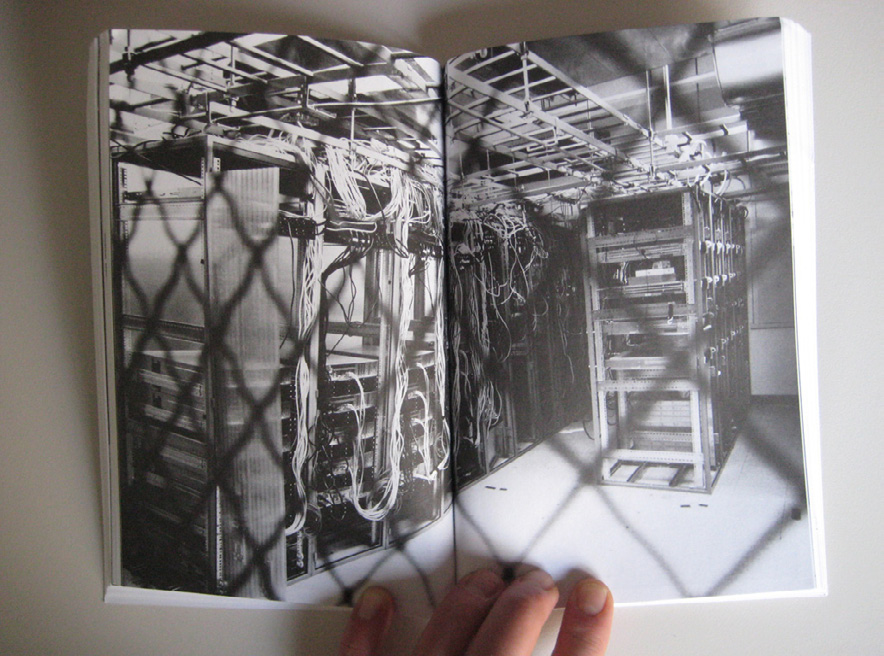
… and a picture of several servers cabinets taken out of Clog: Data Space (2012).
Or should we simply consider the data center figure (and its services) for what it is: the furtive icon of our modernity and of the radically modified relation we maintain to global territory? Should we therefore think about it in even more radical or speculative terms?
Based on the context above, we are calling for proposals under the title of Deterritorialized Living (Beijing sessions) / Inhabiting the Computer Cabinet.
Objective: An abstract space of 9 square meters is proposed for the competition, to be designed into a large computer cabinet that is inhabitable. Its exact shape, height and volume are to be defined by the candidates.
The cabinet can be situated in any natural or artificial place on Earth. It can also be located in an ideal environment (which should be defined in detail). Cooling (natural or artificial) is the only necessary condition: fresh air (and/or other refreshing means) needs to enter the space and to cool down the machines. It is then transformed into hot air charged with positive ions by the processing units that could in turn be used for any other meaningful purposes or symbiotic uses, before eventually being extracted.
The computer cabinet functions as a small data center. A certain number of servers, NAS (networked attached storage), virtual machines, etc. are therefore also installed within this space. The inhabitant(s) have to share the space with the machines in some ways. The status and/or security of the data could also be addressed in some creative ways.
The cabinet is part of a network and can be combined or aggregated with others to form a larger, possibly mobile, mediated and/or networked structure.
Goal: by taking advantage of the physical, informational, computational, chemical, biological, environmental or climatological features of the facility (inside and outside), the project focuses on creating a livable environment within the computer data cabinet (or personal data center). The outcome of the project could be to engage with the overall design or to develop a very specific device, object, software, interface and/or installation within this given framework.
Ressources
http://www.deterritorialized.org is an artificial atmosphere conceived by fabric | ch that is delivered in the form of algorithmically constructed data feeds. It is composed by a set of web services and libraries that were developed in the context of a residency on the Tsinghua University campus in Beijing, between Spring and Summer of 2013 (at TASML). The open data feeds of this "geo-engineered" climate can be addressed and used by any custom designed program or device (the website will be open from the 6th of September).
These open-source, “ambient deterritorialization” data feeds and environments in the form of Deterritorialized Air (N2, O2, CO2, Ar), Deterritorialized Daylight (Lm, IR, UV) and Deterritorialized Time can be freely used in the context of this competition.
Eligibility / Rules
The call is open to all students and young faculty members of Tsinghua University. The application should include candidate’s name and school or department affiliation.
The Award of Distinction of US$ 1000 is open to international submissions.
Works submitted by individuals or teams are all welcome. However we highly encourage interdisciplinary, transdepartmental team participation. All submissions should be written in English.
Submissions shall not be published or made public in other venues until a final decision by the jury is made public.
Submission Deadline
The submission deadline is October 14, 2013, 10pm Beijing time.
Any uncompleted submission by the time of the deadline will be excluded from judgment by the Jury.
Schedule
Competition launch: August 30, 2013
-
Final Submission: 10pm (Beijing time), October 14, 2013
-
Announcement of winning entries and mentions: November 1, 2013
-
Presentation by the winning team in Lisbon at the Lisbon International Architecture Biennial Close, Closer, Portugal: December 14, 2013
Submission Guidelines
Email submission, in one email with one pdf file attached, to call@deterritorialized.org, maximum size limit is 20mb, with the title of the message as the title of your project.
File to be attached to your mail:
One pdf document in A3 horizontal layout (labelled: name-of-my-project.pdf), to be screened (the jury will look at your proposition on screen), containing the following, not exceeding 8 pages:
A - Information
- Title of the project.
- Name / surname, Tsinghua school or department affiliation (or profile for Award of Distinction), email address and date of birth of the representing member for the team (one person only).
- Names / surnames, Tsinghua school or department affiliation (or profile for Award of Distinction), email addresses and dates of birth of all other members of the team.
- Short descriptive biography (not exceeding 150 English words of each individual).
- Links to additional visual materials, including video, website, etc., if needed.
B - Project
- Images and diagrams summary of the project (most important elements, in screen quality).
- Project concept: describe the conceptual reasoning of the project.
- Project description: describe what it does practically.
- Technical description: describe the technical components of the project.
Note:Proposal should be written in English. Project title should be listed in the lower right corner of each page on all documents.
Evaluation guidelines
Transformative potential, speculation, risk taking, and the originality yet feasibility of the proposal will be key factors for the jury.
Quality of presentation and documentation (including technical, scientific description and visual presentation).
Note:
The project shouldn’t be a “fantasy”. Its feasibility should be proven in some ways (demo, mockups, proofs of concept, technical schemes), even though the technologies proposed might still be in their research phase.
Jury members
An international jury will select the winning proposal. Jury members will be disclosed along with the announcement of the winning candidates.
Awards / Prizes
Two prizes will be awarded by the jury, along with two honorary mentions.
1st prize: A trip for the winner or one representative of the winning team to Lisbon (including airfare and hotel) to present the results of their proposal during a talk, along with fabric | ch and TASML. Free viewing of the Triennial Close, Closer.
2nd prize: 3000 RMB.
2 honorary mentions
Award of Distinction
Price: 1000 US Dollars
This award is open to international submissions from students and professionals.
About the organizers
fabric | ch is a Swiss based art and architecture studio that combines experimentation, exhibition and production. It formulates new architectural proposals and produces singular livable spaces that mingle territories, algorithms, “geo-engineered” atmospheres and technologies. Through their works, the architects and scientists of fabric | ch have investigated the field of contemporary spaces, from networked related environment to the interfacing of dimensions and locations such as their recent works about “spatial creolization”.
TASML (Tsinghua University Art and Science Research Center Media) is conceived as a research and production unit that aims to synergize the rich resources available among the University’s diverse research institutions and laboratories to create an incubator for crossbred, interdisciplinary experiments among artists, designers, scientists and technologists. TASML also functions as a center and a hub for worldwide exchange and collaboration both with academic and research institutions and the global media art and design community. Through information sharing and knowledge transfer, TASML can also be seen as a catalyst of innovations for other disciplines in the arts and for the creative industry in general.
COWORKLISBOA is a 750 m2 shared office for startups, nano companies and independent or mobile professionals such as designers, architects, illustrators, translators, among others. Getting fat and lazy @ home? Come, it is at LX Factory and Central Station in Lisbon.
Close, Closer, the third Lisbon Architecture Trienale will put forward an alternative reading of contemporary spatial practice from the 12th of September to the 15th of December in Lisbon, Portugal. For three months chief curator Beatrice Galilee and curators Liam Young, Mariana Pestana and José Esparza Chong Cuy will examine the multiple possibilities of architectural output through critical and experimental exhibitions, events, performances and debates across the city.
Related Links:
fabric | rblg
This blog is the survey website of fabric | ch - studio for architecture, interaction and research.
We curate and reblog articles, researches, writings, exhibitions and projects that we notice and find interesting during our everyday practice and readings.
Most articles concern the intertwined fields of architecture, territory, art, interaction design, thinking and science. From time to time, we also publish documentation about our own work and research, immersed among these related resources and inspirations.
This website is used by fabric | ch as archive, references and resources. It is shared with all those interested in the same topics as we are, in the hope that they will also find valuable references and content in it.

